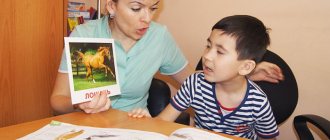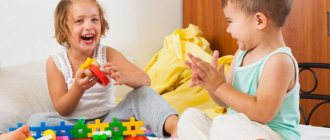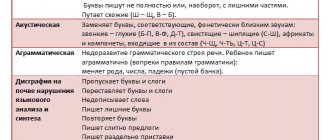Many of us have heard complaints from acquaintances, girlfriends or mothers on the playground that their child is distracted and inattentive. Or maybe you yourself have encountered similar difficulties in raising a child, when you talk to him, tell him, but he just doesn’t hear you? He listens, but doesn’t understand or doesn’t remember! You can solve this problem or prevent its occurrence with the help of special games to develop attention in children, and you should start as early as possible!
What is attention?
Attention is a method of directed perception of one or more objects through different senses. This process can be either conscious or unconscious.
It is necessary to develop attention in a child from an early age, which will later manifest itself favorably in:
- his abilities for learning and intellectual development;
- increasing memory capacity and training thought processes;
- adaptability to life and living conditions.
An important point is the fact that without developed attention it is impossible to obtain even average results in the development of memory and thinking. Therefore, classes are not just desirable, but necessary, no matter who the child becomes in the future!
Types of attention
In addition to properties, attention is also divided into types, depending on the senses involved:
- visual;
- auditory;
- kinesthetic;
- motor-propulsion;
- taste;
- olfactory and others.
Eg:
- the person watching the pantomime has active visual attention;
- when listening to your favorite song - auditory;
- for a taster of a new type of chocolate - olfactory and gustatory;
- at the moment of fencing - mainly visual and motor-motor;
- and the kinesthetic one manifests itself during control of the strength of the handshake.
Special exercises and activities that can be carried out both at home and in preschool educational institutions will help to comprehensively develop attention. And so that you don’t have to engage in a grueling search for not only useful, but also interesting games, we invite you to familiarize yourself with our selection.
Train now
Train right now on this page, for free and without registration.
Anagrams
Start with anagrams, they will help develop such qualities as: attention, concentration, speed of thought, speed reading. In this game you have to choose 1 option out of 4, in which only those letters that are part of the given word are mixed. Each round a new word is given. Remember that time is limited! The faster you look for the answer, the more points you will get at the end of the game.
Schulte tables
The Schulte table is one of the most effective exercises for developing the brain, attention, concentration, and accelerating visual search. This exercise is also the most popular exercise for developing speed reading. Schulte tables usually consist of randomly placed numbers or letters. The number of cells in tables also varies and most often they are 5x5 elements in size.
Games to develop attention at home
"Merry Bell"
Develops auditory concentration .
To play, you will need a ringing bell and a soft, opaque scarf to blindfold your child. Next, the parent quietly moves around the baby and rings the bell, and the baby must show with his hand where the ringing comes from.
Perhaps the baby will make mistakes right away, but such training will help him learn to abstract from external stimuli and concentrate on a specific sound.
"Memorize words"
Helps increase the volume of auditory attention.
You can play this educational game in any convenient place: on the train, in the car, while walking or on the way home from kindergarten. But it’s better to play the first couple of games at home, so that the baby understands the principle and is not distracted by foreign objects.
So, the adult names three words - the child must repeat them in the same sequence. You can immediately start with the objects around you: a tree, a cloud, the sun. After the baby repeats, increase by 1 word reaching 5-6 at a time. In the future, you can increase the amount until the child begins to get confused, and you can complicate the task by naming words that are not related to each other in meaning.
"One-one, two-two"
If everyone in your family has a positive attitude towards games, try a more fun game. It will help develop not only the volume of auditory attention, but also its concentration and switchability .
So, the minimum number of players is 3 people, but the more, the merrier. Each one is assigned a number in random order: 1.1, 2.2, 3.3 and so on.
The one with the first number starts the game with the words: “One-one - three-three” (or any other number). The person with the number “three-three” picks up the game, and starting from his serial number passes the baton to another: “Three-three - two-two” and so on.
The goal of the game is to take the baton on time and pass it on to the next one. If one of the players:
- gape,
- got lost
- got something mixed up
- got in out of turn
he loses his number and receives a nickname, for example, “flower”, and now when passing the baton, he will be addressed not “three-three”, but “flower”, and he must also say: “Flower - one-one”.
In the case when a person with a nickname makes a mistake again, he is assigned one more in addition to the existing one, for example, “flower, cloud” and so on. It is worth determining in advance what the maximum number of nicknames is acceptable and it is important that they are not repeated among the participants.
You can play with older children in a knockout game, that is, if you get 6 nicknames, you’re eliminated. With preschoolers, it is better to choose a win-win tactic, for example, until everyone gets 4 nicknames. Thus, next time the baby will be happy to take part, since he will receive only positive emotions. If you play often, increase the difficulty, for example, every month “+1” nickname.
"Songs in Motion"
Kids love rhythmic songs. But with their help you can not only entertain the baby, but also develop concentration and switchability of auditory and motor-motor attention.
To play the game you will need a simple children's song, for example, known to many people. The words are as simple as possible, audible and repeated.
For each phrase we define our own movement:
- “Aram zam zam” - tapping the knees in ri;
- “Guli Guli” - we rotate our hands in front of us, rearranging them sequentially in a circle (this is also how they show how the lottery drum spins);
- “Arafik arafik” - we stroke ourselves on the head on the first “arafik” with our left hand, on the second “arafik” with our right hand.
We turn on the song and repeat the movement with the baby. Please note that the further you go, the faster the song plays, so for starters, the first two verses will be enough, and when the baby stops getting lost, you can speed up.
If your child doesn’t succeed, hum the song yourself, choosing the slowest possible tempo so that the child catches the essence and connection, and after three or four a cappella performances, you can move on to the original song.
Look for similar melodies and come up with your own movements together with your baby. For example, you can take the song “Dance of the Ducklings” as the basis for the next one. The basic movements will be familiar to many parents from childhood.
"Hide and Seek with a Toy"
Most children, starting from the age of two, love to play hide and seek. What if their favorite toy plays with them? Such unique games with “sound cues” will help develop auditory concentration and stability of auditory attention.
Choose with your baby what toy you will play with today and explain to him the following rules. While he turns away and counts to five, the toy, with his mother’s help, will hide in the room. As he gets closer to her location, mom will clap her hands louder and more often, and move away - quieter and less often. You can replace the “claps” with a whistle or a children’s pipe, the main thing is that you can adjust the volume of the sound produced.
"What's missing?"
Develops the scope of visual attention.
So, you will need from 3 to 7 toys, of any shape and size. Place them in front of your child and let him look at each one carefully. Next, ask them to turn away for a while, and hide one of them yourself. Turning around, the baby must determine which toy is missing.
For children from 18 months, 3 toys will be enough, and as they grow older and the volume of visual memory increases, you can increase the number to 7. Also, for variety, you don’t have to hide the toys, but swap them.
"Shy numbers"
The game is suitable for those kids who know at least 5 numbers. Classes will help develop concentration , stability and visual attention span .
Take 5 cards with numbers. If not, do it yourself:
- cut out 5 identical rectangles of any size from a sheet of thick cardboard;
- leave one side clean - this will be the shirt;
- on the second, write the numbers from 1 to 5 so that they are not visible from the side of the shirt.
Place the cards in any order in front of the child, numbers facing up. Let him look at them and try to remember. Next, turn all the cards face down and ask them to show, for example, the number “2”. The kid must turn over the card where, in his opinion, it is “hidden”. If you didn’t guess correctly, he turns it back face down and tries to find it among the other cards. When the child finds the “hidden” number, leave it open and ask him to find the next one.
The game continues until the baby finds all the named numbers. It becomes more complicated by adding new numbers, but not more than 10 (from “0” to “9”).
If learning numbers doesn’t work out, then draw simple and understandable objects on cards: a flower, a house, a bird, a sun, a cloud, etc. and play by analogy.
"Cinderella"
Promotes the development of stability , concentration , distribution and switching of visual attention.
For the game, prepare three empty plastic plates and three types of cereals, legumes or cereals. For initial exercises, it is better to select larger ones, for example: beans, sunflower seeds and corn or peas, beans and lentils.
Next, mix a few pieces of each group (3-5) in a small container and ask the baby to sort this “assortment”, placing each type in the appropriate plate.
The older the child, the smaller the grains you can take: buckwheat, rice, pearl barley. To complicate the task, do not give large volumes, but simply add 1 cereal at a time, but watch the behavior, if the baby cannot cope, remove one type from the “assortment”.
"Buttons"
Such activities will help develop concentration and visual attention span.
The game is designed for two. Prepare two identical sets of different buttons and two playing fields; for this, divide a sheet of A4 paper into 4-6 large cells. As complexity increases, the number of cells will increase and their size will decrease. Instead of buttons, you can take chips from a children's poker game, tokens or other items, the main thing is that there are two of them and the pairs are not repeated with others.
Place 1 game board and 1 set of buttons in front of you and your child. Place any 3 buttons on your field, 1 in each cell. You choose the order and location at your discretion. Give your child 20-30 seconds to look at the field with buttons - let him remember their location. Then cover your field with the buttons laid out with a sheet of paper and ask the baby to repeat the same arrangement of buttons.
After completing the task, let the child come up with his own combination, and you repeat it from memory.
As the game becomes more complex, the number of buttons and, accordingly, cells on the playing field are added.
"Warning Lights"
A fun game that will help develop stability and concentration of visual attention.
Suitable for children who can count to at least three. You need to play in the dark. To play, you will need an ordinary children's flashlight (dimmed) and symbols that you have come up with.
For example, shine a flashlight on the ceiling or wall:
- two short times - the baby must make a jump;
- two long ones - sit down;
- one short one - clap your hands;
- three long ones - pat you on the shoulder, etc.
Developing attention: 3 tips on how to achieve success by training attention switching
It is recommended to train attention switching simultaneously in three directions:
1. Training the speed of switching attention from one process or object to another; the goal is to reduce the time it would normally take to do something else and focus entirely on that.
Place a ticking clock next to you. Start reading something not very binding
Switch your attention either to the ticking of the clock or to reading the text. Very soon you will get stuck in one thing.
Try to make progress by increasing the number of switches and the time it takes to complete this task without failure.
Lie on your back and start listening to your bodily sensations
Start with your head, then switch your attention to your arms, then to your stomach, back, etc. “Walk” through your body, including sensations in different places
Gradually increase your switching speed.
2. Developing the ability to identify the most important and secondary objects of perception, and then, if necessary, change their places so that what was previously secondary now becomes important; The task is to learn to quickly find the necessary “markers” of the situation.
Lie on your back and start listening to your bodily sensations
Start with your head, then switch your attention to your arms, then to your stomach, back, etc. “Walk” through your body, including sensations in different places
Change the “pattern” of your switches by asking yourself commands which part of your body you want to feel now
3. Independent construction or development of a ready-made “perception route” - the use of special reference signals that are needed when work processes follow a specific order; the goal is to help consciousness follow the usual path. In some cases, they even use different mnemonics
Here's how, for example, drivers were recently taught how to manage their attention:
Comrade! This is not a pro forma, sir!
Remember when going into the distance:
Clutch. Broadcast. Brake.
Turn sign. Gas. Pedal.
Draw your own route maps, following which you will switch your attention in the order specified by the map. You can rhyme the sequence of objects to make it easier to remember
As the heroine of the old film “The Sound of Music” did, drawing up a map of notes: “C – we value this sound, D – decisively forward...”
Games to develop attention in pictures
Hidden Objects
There are many different toys and characters in the picture. Look at it carefully and try to find the objects that are drawn below on the white line.
If that doesn't work, skip and move on to the next "wanted item." The task can be completed in several approaches.
Find differences
Two identical, at first glance, pictures have their own subtle differences. Try to find them all, and pay attention not only to the scuba diver and underwater inhabitants, but also to the algae and objects around.
We'll give you a little hint - there are only 10 differences in two pictures. To avoid confusion, print out the task and circle the differences as you find them.
Labyrinths
The children played a prank on the dog and tied the bone to a rope, after which it became entangled with others. Help him find the rope with the treasured treat attached to it.
You can search either with your finger, carefully “untangling” the knots of the labyrinth, or by drawing lines with a pen or pencil to make it easier to get to the goal.
Find two identical pictures
The picture shows animals that are similar at first glance, but there are still differences in them, except for two pictures that are completely identical. Look carefully and find them.
Cheerful little mice slide down a snowy slope. Some are wearing a hat, others are wearing helmets, some are laughing, and the rest are just smiling. There are also differences in skis, clothes and fur color, but the two mice have everything exactly the same - find them.









